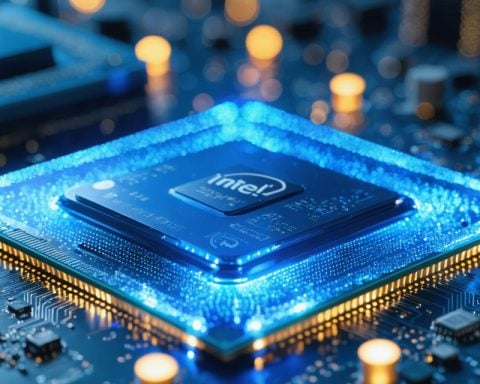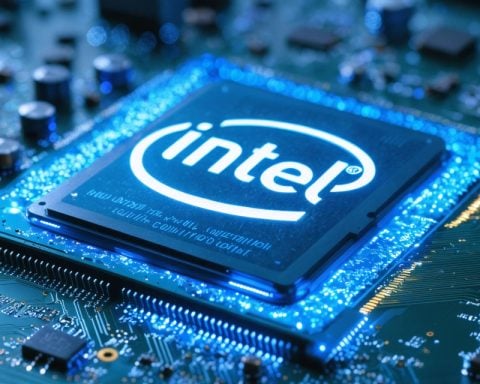Nvidia is gearing up to transform the tech landscape with its revolutionary Blackwell chip, projected to be the standout story of 2025. According to Morgan Stanley, this next-generation GPU is set to alleviate investor concerns and fuel a 20% stock surge.
In a recent report, Morgan Stanley reaffirmed its “overweight” rating on Nvidia, designating it as their “top pick” for the coming year. The bank’s optimism springs from Blackwell’s expected triumph — a cutting-edge chip with advanced AI capabilities. Analysts propose a future stock price of $166, marking a 23% increase from its current value of $134.82.
The bank’s strategists suggest that, while Nvidia faces transitional challenges, by mid-2025, conversations will likely revolve solely around Blackwell’s impressive capabilities. Investor confidence is already on the rise, with Blackwell’s slated launch in early 2025. Nvidia’s stock experienced a boost after CEO Jensen Huang highlighted the unprecedented demand for Blackwell, further elevating Wall Street’s profit forecasts.
Nvidia’s promising new chip could also quell short-term anxieties surrounding the stock. For instance, a slowdown in the production of its current-generation AI chips, Hopper, is viewed as a temporary issue by Morgan Stanley. Despite concerns over staggered shipments of Blackwell’s variants, analysts expect full sales coverage throughout the year.
By the latter half of 2025, Nvidia’s Blackwell is anticipated to be the driving force behind significant revenue growth, potentially dispelling any lingering investor worries.
Nvidia’s Blackwell Chip: The Game-Changer in Tech for 2025
Nvidia is poised to make headlines with its revolutionary Blackwell chip, projected to be the pivotal tech innovation story of 2025. This next-generation GPU is not just a beacon of technological prowess but also a major catalyst for Nvidia’s expected stock resurgence. Morgan Stanley’s analysis suggests a remarkable 20% increase in Nvidia’s stock, attributing this rise primarily to Blackwell’s capabilities.
Features and Specifications
While specific technical specifications for Blackwell remain under wraps, industry insiders expect it to feature state-of-the-art AI capabilities that will far surpass current-generation GPUs. This new chip is predicted to offer superior computational power, energy efficiency, and enhanced processing speeds, catering to an ever-growing demand for more robust AI and machine learning applications.
Innovations and Predictions
The Blackwell chip is at the center of Nvidia’s strategy to maintain its dominance in the semiconductor industry. Speculative reports suggest that it will incorporate advanced semiconductor technology, leveraging recent innovations in chip manufacturing. This could include smaller process nodes and new materials, which might set new benchmarks for performance and efficiency.
Market Impact and Investor Confidence
Morgan Stanley’s analysts have shown unwavering optimism regarding Nvidia’s prospects, reaffirming an “overweight” rating and heralding it as the “top pick” for 2025. Investors seem increasingly confident, as evidenced by a heightened interest following Nvidia CEO Jensen Huang’s commentary on the unprecedented demand for Blackwell. Their strategic predictions include a future stock price of $166, indicating a potential 23% increase from the present value of $134.82.
Use Cases and Applications
The Blackwell chip is expected to revolutionize various sectors by driving technological advancements in artificial intelligence, autonomous vehicles, cloud computing, and gaming. These sectors are predicted to benefit significantly from the chip’s enhanced processing capabilities, potentially leading to groundbreaking innovations and applications.
Comparisons: Blackwell vs. Hopper
Compared to Nvidia’s current Hopper chip, Blackwell is anticipated to provide substantial improvements in performance and efficiency. While the Hopper has been a strong player in AI processing, the Blackwell chip aims to resolve existing bottlenecks related to speed and power consumption. This transition highlights Nvidia’s commitment to continuous innovation and adaptation to market needs.
Challenges and Limitations
Despite the promising outlook, Nvidia faces potential challenges related to production and supply chain dynamics. The recent slowdown in Hopper chip production serves as a reminder of the unpredictable nature of semiconductor manufacturing. However, analysts at Morgan Stanley view these challenges as temporary, expecting the full rollout of Blackwell to rectify these issues by late 2025.
Conclusion: The Future of Nvidia with Blackwell
Nvidia’s Blackwell chip is poised to be a transformative force in the tech industry, underpinning significant advancements and potentially leading to substantial revenue growth. By overcoming transitional hurdles and capitalizing on Blackwell’s potential, Nvidia is well-positioned to maintain its leadership in the evolving landscape of technology.
For more information on Nvidia and its latest innovations, visit Nvidia’s official site.


















